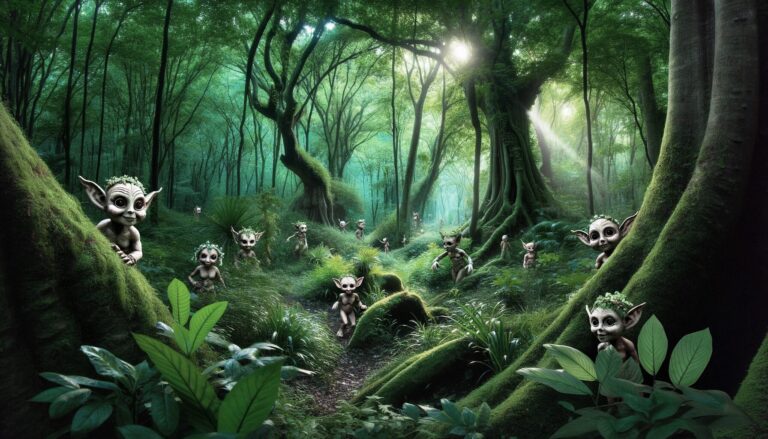Table of Contents
 In the heart of Mexican folklore, hidden deep within the lush jungles and dense forests, there exists a race of mythical beings known as the Chaneques. Moreover, these elusive creatures are a source of fascination and intrigue, captivating the imagination of generations with their enigmatic presence and mysterious nature.
In the heart of Mexican folklore, hidden deep within the lush jungles and dense forests, there exists a race of mythical beings known as the Chaneques. Moreover, these elusive creatures are a source of fascination and intrigue, captivating the imagination of generations with their enigmatic presence and mysterious nature.
Origins and Family
The Chaneques are believed to be ancient spirits or forest-dwelling beings deeply rooted in the mythology of indigenous Mexican cultures, particularly the Aztecs and the Mayans. In some interpretations, they are considered to be the offspring of Tlaloc, the god of rain and fertility, which grants them their connection to the natural world.
Chaneques are often depicted as mischievous, child-sized beings with distinct physical characteristics. Moreover, they are typically described as having long, unkempt hair that flows like the vines of the jungle. In addition, their skin is said to be a deep shade of green or brown, perfectly camouflaging them within the dense vegetation. Furthermore, their eyes, resembling sparkling emeralds, are believed to hold a world of secrets and mischief.
Appearance
Childlike Appearance: Chaneques are often described as looking like small children, with the same proportions and stature. This childlike appearance can make them appear innocent and playful.
Clothing: Chaneques are usually depicted wearing traditional indigenous clothing, such as loincloths or tunics. Their clothing may be tattered or made from natural materials like leaves or bark.
Physical Features. Chaneques are said to have distinctive physical features, such as long, unruly hair that covers their faces and large, expressive eyes. Some accounts suggest that their eyes can glow or have a supernatural quality.
Animal Traits. In some versions of Chaneque folklore, they are associated with animals and may have animal-like features, such as animal ears or tails. This connects them to the natural world and the spirits of the forest.
Shape-Shifting: Chaneques are often believed to have the ability to shape-shift or camouflage themselves to blend in with their surroundings, making them elusive and difficult to spot.
Abilities
Chaneques possess a range of extraordinary abilities that make them both formidable and intriguing figures in Mexican mythology:
Shape-shifting: Chaneques are master shape-shifters, capable of taking on various forms, including animals and plants. This shape-shifting ability allows them to move undetected and interact with humans and animals without raising suspicion.
Illusions and Deception: Chaneques have a knack for creating illusions and tricks that can confuse and mislead unsuspecting travelers. They use these skills to protect their forest habitats from intruders.
Guardians of the Forest: While they can be mischievous, Chaneques are also known to be guardians of the forest. They watch over the flora and fauna, ensuring the delicate balance of nature is maintained.
Time Distortion: Some legends suggest that Chaneques have the power to manipulate time, making it seem as if moments stretch on endlessly or pass in the blink of an eye. This ability adds to their mystique and unpredictability.
Symbols Representing Chaneques
Chaneques are deeply associated with the natural world, and as such, their symbols often reflect their connection to the forest and its mysteries. Some common symbols representing Chaneques include:
Leaves and Vines: These symbols represent the Chaneques’ affinity for the forest and their ability to blend seamlessly with the flora.
Emerald Eyes: The sparkling green eyes of the Chaneques are a symbol of their otherworldly nature and their connection to the natural world.
Animal Tracks: Footprints resembling those of small animals are often linked to the presence of Chaneques, signifying their shape-shifting abilities.
Mysterious Laughter of Chaneques is a symbol of their playful and unpredictable nature, as well as a warning to those who might cross their path.
Myths and Stories

The Chaneques inspiring a myriad of myths and stories that continue to be passed down through generations. Here are a few captivating tales that shed light on these elusive creatures:
The Lost Traveler. In this story, a lost traveler ventures deep into the heart of the forest, where he encounters a group of Chaneques. They play tricks on him, making the forest appear endless and disorienting. Eventually, the traveler manages to escape, forever changed by his encounter with the Chaneques.
The Chaneque’s Challenge: Another tale tells of a brave young man who, in his quest for adventure, dares to challenge a Chaneque to a game of wits. The Chaneque, impressed by the young man’s courage, agrees. The ensuing contest of riddles and illusions is both thrilling and thought-provoking.
The Forest Protectors: Chaneques are often depicted as protectors of the forest. In this story, they come to the aid of a group of animals threatened by human encroachment. Through their cunning and magical abilities, the Chaneques help the animals reclaim their habitat and live in harmony once more.
The Chaneque’s Lament: In this melancholic tale, a Chaneque falls in love with a human. However, their love is forbidden, and they are destined to remain apart. The Chaneque’s heartache and longing for the human world serve as a reminder of the complexities of love and desire, even for mythical beings.
In Mexican culture, Chaneques are often seen as protectors of the forests and guardians of the natural world. They remind humans of the importance of respecting the environment and the delicate balance of the ecosystem. Their mischievous nature also serves as a cautionary tale, warning travelers to be mindful and respectful when venturing into the wilderness.
Interactions with Humans
Chaneques, as described in Mexican folklore, are known for their interactions with humans, which can be both playful and mischievous. Here are some ways in which Chaneques are believed to interact with humans:
Playing Tricks: Chaneques are notorious for playing pranks and tricks on humans, often in forested or rural areas. These tricks can range from simple pranks like hiding personal belongings to more elaborate schemes.
Additionally, Chaneques are said to have the ability to mimic human voices and sounds, which they may use to confuse people. For instance, they might call out the names of unsuspecting travelers or imitate the cries of animals to lead people astray.
When it comes to leading people astray, Chaneques are sometimes blamed for this in the wilderness. They may create illusions, making it difficult for people to find their way back to familiar paths or landmarks.
Scaring or Testing Humans. In some stories, Chaneques are known to scare or test the courage of humans who enter their territory. These tests can be used to determine whether the person is respectful of nature or is intruding into their domain.
Helping or Hindering: Chaneques are not always malicious; they can also be helpful if treated with respect. Some stories suggest that they assist lost individuals or provide guidance to those who respect the natural world and the spirits of the forest.
Accepting Offerings: It is believed that Chaneques may appreciate offerings left for them, such as food, tobacco, or other items. Offering gifts is a way to show respect and seek their favor, potentially leading to more positive interactions.
Respecting Boundaries: Folklore often emphasizes the importance of respecting Chaneque territory. Entering their domains without proper care or consideration can lead to encounters with their mischievous behavior.
Similarities
Leprechauns (Ireland): Leprechauns are small, mischievous fairies from Irish folklore. They are often depicted as elderly, bearded men in green coats and hats. Like Chaneques, they are known for their playful and tricky nature, as well as their ability to hide and avoid being seen.
Brownies (Scotland and England): Brownies are household spirits in Scottish and English folklore. They are usually described as small, helpful creatures who perform chores in homes but are shy and prefer to work in secret. Brownies share a connection with nature and can be elusive like Chaneques.
Nisse/Tomte (Scandinavia): Nisse in Denmark and Norway and Tomte in Sweden are similar to brownies. These small, gnome-like creatures are believed to inhabit farms and help with chores, but they can also play tricks.
Pukwudgies (Native American folklore, specifically in the Wampanoag tradition): Pukwudgies are small, human-like beings with magical abilities. They are often considered mischievous and may play tricks on humans. They are associated with forests and wilderness areas.
Duwende (Philippine folklore). These mystical beings, often described as mischievous, elusive, and protective, have etched their presence into the rich tapestry of Filipino mythology.
Kobolds (Germanic folklore): Kobolds are mythical beings in Germanic folklore, often depicted as small, impish creatures. They are known for their capricious behavior, including playing tricks on people and hiding objects.
Kitsune (Japanese folklore): Kitsune are fox spirits in Japanese mythology.
FAQ
What do Chaneques look like?
Chaneques are typically depicted as small, child-sized beings with long, unkempt hair and deep green or brown skin.
Where are Chaneques believed to live?
Chaneques are said to inhabit dense forests and jungles in Mexico.
What is Chaneques behavior like?
Chaneques are known for playing tricks on humans, mimicking sounds, and occasionally leading people astray in the wilderness.
Can Chaneques be friendly or helpful?
Yes, some stories suggest that Chaneques can be helpful if treated with respect and offerings are made.
Are Chaneques unique to Mexican folklore?
Yes, Chaneques are specific to Mexican folklore and are deeply rooted in indigenous traditions.
Are Chaneques real creatures?
No, Chaneques are mythical beings and are not considered real in a scientific sense. They exist in the realm of folklore and storytelling.






